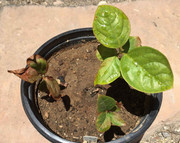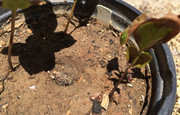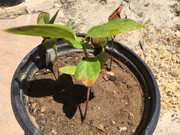76
Tropical Fruit Discussion / Re: Cherimoya Season 2019 (So Cal)
« on: November 01, 2020, 12:05:22 PM »La verne is aware of the bumpo issue and said they would stop selling bumpo because they got the complaints.
Glad to hear that. Thanks!
The Internet's Finest Tropical Fruit Discussion Forum!
"All discussion content within the forum reflects the views of the individual participants and does not necessarily represent the views held by the Tropical Fruit Forum as an organization."
This section allows you to view all posts made by this member. Note that you can only see posts made in areas you currently have access to.
La verne is aware of the bumpo issue and said they would stop selling bumpo because they got the complaints.
Thanks for the input Peter. The potting mix is more or less this:
40% - Pine Bark
20% - Coco Coir
15% - Bio Char
10% - Pool Filter Sand
5% - Perlite
5% - Vermiculite
5% - Earthworm castings
I got 2 of the bunk bumpos. They are dr whites. I agree it sucks and bad biz. Im going to top work one of mine to a real bumpo. Bow you got a big tree, start grafting it up.
Although now I am questioning the knight variety. It looks the same as honeyhart and is earlier than the other trees.
...I had some other lavern trees mislabeled so Im thinking the knight is maybe actually a honeyhart.


Also they don't like to be watered. I don't have irrigation on any.
Thanks Karen! I think the ones I have been seeing are bisexual, since they have what looks like a very long pistil in the center of the flower. Unless looks are deceiving...
Cheers,
Carolyn



I get my online Mangos from Mangozz.com I get the rest of my Mangos by growing them myself or from my friends orchards around San Diego.
Simon
you may be better off driving to Cerritos and buying from Indian stores. They always have Alphonso, Kesar, Bengalpali, and few others. However, Paki mangoes suck, for whatever reason they turn out over 50% fermented whether you buy from online or in store.
Little India is technically in Artesia, which neighbors Cerritos. Pioneer Cash & Carry is a good place to pick them up when available
Hey Simon, I was referring to the horizontal gene transfer which the plants seem to be undergoing when they are inarched together as with your double rootstock experiments. One of the articles I was reading made it sound like the horizontal gene transfer ( or mixing of genes to produce a new species) was possible when grafting the two rootstocks together. But I was trying to make sure I was understanding the article correctly in my interpretation. It seems they were saying that gene mixing, asexually, is possible from the graft site of two species inarched together. So, on your DSG mango with one rootstock cut off, would the resulting material above the graft site have chromosomes from both rootstocks or just one? That goes back to my question about whether shoots coming from only the graft site are genetically mixed ( horizontal gene transfer) or if anything above the graft is then genetically manipulated. Again, I am very novice and my interpretation may be totally wrong. Just wondering as this may have implications in the future for mango hybridization, like your experiments...Thanks!
E.
•And finally, there's the little Nitidulid beetle, which is pollinating anonnas in Florida: https://academic.oup.com/ee/article-abstract/23/4/878/411821?redirectedFrom=fulltext . Maybe I can get these little guys to help me out!
not very responsible government spends billions to prevent invasive species and here you want to potentially introduce one just because you are too lazy to hand pollinate
Some varieties of Cherimoyas have been mentioned to be somewhat self fertile. Booth is one of these varieties. I’ve had some fruit, about three without hand pollination but the fruit were small and misshaped.
http://tropicalfruitforum.com/index.php?topic=20999.0
As I mentioned in another thread, large Cherimoya trees like the one at Exotica Nursery have tons of fruit without hand pollination but there are plenty of insects and other Cherimoya varieties around their huge tree. The fruit are mostly small and misshaped.
Another alternative is to plant a Cherimoya hybrid. Some Cherimoya hybrids produce good size fruit of excellent quality without hand pollination. Leo Manuel has a couple Cherimoya x Atemoya hybrids that are excellent tasting and self pollinating.
http://tropicalfruitforum.com/index.php?topic=19336.msg315950#msg315950
Simon
